Submitted:
05 March 2024
Posted:
06 March 2024
You are already at the latest version
Abstract
Keywords:
1. Introduction
2. Materials and Methods
2.1. Characterization of Bakken Oilfield Produced Water
2.2. Experiments
2.2.1. Precipitative Softening of Produced Water
2.2.3. Precipitative Lithium of Produced Water
3. Results
3.1. Metal Ion Extraction from Produced Water
3.2. Lithium Enrichment
4. Conclusion
References
- Aaldering, L.J.; Song, C.H. Tracing the technological development trajectory in post-lithium-ion battery technologies: A patent-based approach. Journal of Cleaner Production 2019, 241, 118343. [Google Scholar] [CrossRef]
- Ajao, A., & Lim, Y. H. (2023). Sustainable Management of Dams and Reservoirs in North Dakota: Sediment Transport Characterization.
- Aljarrah, S.; Alsabbagh, A.; Almahasneh, M. Selective recovery of lithium from Dead Sea end brines using UBK10 ion exchange resin. The Canadian Journal of Chemical Engineering 2023, 101, 1185–1194. [Google Scholar] [CrossRef]
- Almousa, Mousa, Tomomewo Olusegun, Yeo Lim, Kamel Al-Zboon, Islam Khraisat, Ali Alshami, and Bashaar Ammary. "Chemical recovery of magnesium from the Dead Sea and its use in wastewater treatment." Journal of Water, Sanitation and Hygiene for Development (2024): washdev2024267.
- U.S. EPA (U.S. Environmental Protection Agency).
- Almousa, Mousa, Tomomewo S. Olusegun, Yeo Howe Lim, Islam Khraisat, and Adewale Ajao. "Groundwater Management Strategies for Handling Produced Water Generated Prior Injection Operations in the Bakken Oilfield." In ARMA/DGS/SEG International Geomechanics Symposium, pp. ARMA-IGS. ARMA, 202.
- Almousa, Mousa; Tomomewo, Olusegun Stanley; and Lim, Yeo Howe, "Salts Removal as an Effective and Economical Method of Bakken Formation Treatment" (2023). Civil Engineering Posters and Presentations https://commons.und.edu/cie-pp/1.
- Daitch, P.J. Lithium Extraction from Oilfield Brine. Master’s Thesis, The University of Texas at Austin, 2018.
- Disu, B., Rafati, R., Haddad, A. S., & Fierus, N. (2023, September). Lithium Extraction From North Sea Oilfield Brines Using Ion Exchange Membranes. In SPE Offshore Europe Conference and Exhibition (p. D021S004R001). SPE.
- Flexer, V.; Baspineiro, C.F.; Galli, C.I. Lithium recovery from brines: A vital raw material for green energies with a potential environmental impact in its mining and processing. Science of the Total Environment 2018, 639, 1188–1204. [Google Scholar] [CrossRef]
- Gregory, K.B.; Vidic, R.D.; Dzombak, D.A. Water management challenges associated with the production of shale gas by hydraulic fracturing. Elements 2011, 7, 181–186. [Google Scholar] [CrossRef]
- Kumar, A.; Fukuda, H.; Hatton, T.A.; Lienhard, J.H. Lithium recovery from oil and gas produced water: a need for a growing energy industry. ACS Energy Letters 2019, 4, 1471–1474. [Google Scholar] [CrossRef]
- Lai, X.; Xiong, P.; Zhong, H. Extraction of lithium from brines with high Mg/Li ratio by the crystallization-precipitation method. Hydrometallurgy 2020, 192, 105252. [Google Scholar] [CrossRef]
- Massari, S.; Ruberti, M. Rare earth elements as critical raw materials: Focus on international markets and future strategies. Resources Policy 2013, 38, 36–43. [Google Scholar] [CrossRef]
- Mauk, J.L.; Karl, N.A.; San Juan, C.A.; Knudsen, L.; Schmeda, G.; Forbush, C.; Van Gosen, B.S.; Mullins, M.; Scott, P. The critical minerals initiative of the US geological survey’s mineral deposit database project: USMIN. Mining, Metallurgy & Exploration 2021, 38, 775–797. [Google Scholar] [CrossRef]
- Shi, C.; Jing, Y.; Xiao, J.; Wang, X.; Yao, Y.; Jia, Y. Solvent extraction of lithium from aqueous solution using non-fluorinated functionalized ionic liquids as extraction agents. Separation and Purification Technology 2017, 172, 473–479. [Google Scholar] [CrossRef]
- Shrestha, N.; Chilkoor, G.; Wilder, J.; Gadhamshetty, V.; Stone, J.J. Potential water resource impacts of hydraulic fracturing from unconventional oil production in the Bakken shale. Water Res. 2017, 108, 1–24. [Google Scholar] [CrossRef]
- Somrani, A.A.H.H.; Hamzaoui, A.H.; Pontie, M. Study on lithium separation from salt lake brines by nanofiltration (NF) and low pressure reverse osmosis (LPRO). Desalination 2013, 317, 184–192. [Google Scholar] [CrossRef]
- Song, Y.; Zhao, Z. Recovery of lithium from spent lithium-ion batteries using precipitation and electrodialysis techniques. Separation and Purification Technology 2018, 206, 335–342. [Google Scholar] [CrossRef]
- Al-Qudah, S.; Yang, M. Large Displacement Detection Using Improved Lucas–Kanade Optical Flow. Sensors 2023, 23, 3152. [Google Scholar] [CrossRef]
- Talens Peiró, L.; Villalba Méndez, G.; Ayres, R.U. Lithium: Sources, production, uses, and recovery outlook. Jom 2013, 65, 986–996. [Google Scholar] [CrossRef]
- Tandy, S. , Caniy, Z. LITHIUM PRODUCTION FROM HIGHLY SALINE DEAD SEA BRINES. Rev. Chem. Eng. 1993, 9, 293–318. [Google Scholar] [CrossRef]
- Torres, L.; Yadav, O.P.; Khan, E. A review on risk assessment techniques for hydraulic fracturing water and produced water management implemented in onshore unconventional oil and gas production. Sci. Total Environ. 2016, 539, 478–493. [Google Scholar] [CrossRef]
- USGS, 2020a. Data on the domestic production and use of Li. https://pubs.usgs.gov/periodicals/mcs2020/mcs2020-lithium.pdf.
- Valdez, S. K., Flores, H. R., & Orce, A. (2016). Influence of the evaporation rate over lithium recovery from brines.
- Virolainen, S.; Fini, M.F.; Miettinen, V.; Laitinen, A.; Haapalainen, M.; Sainio, T. Removal of calcium and magnesium from lithium brine concentrate via continuous counter-current solvent extraction. Hydrometallurgy 2016, 162, 9–15. [Google Scholar] [CrossRef]
- Waisi, B.I.H.; Karim, U.F.; Augustijn, D.C.; Al-Furaiji, M.H.O.; Hulscher, S.J. A study on the quantities and potential use of produced water in southern Iraq. Water science and technology: water supply 2015, 15, 370–376. [Google Scholar] [CrossRef]
- Wang, H.; Zhong, Y.; Du, B.; Zhao, Y.; Wang, M. Recovery of both magnesium and lithium from high Mg/Li ratio brines using a novel process. Hydrometallurgy 2018, 175, 102–108. [Google Scholar] [CrossRef]
- Zhang, Y.; Hu, Y.; Wang, L.; Sun, W. "Systematic review of lithium extraction from salt-lake brines via precipitation approaches". Minerals Engineering 2019, 139, 105868. [Google Scholar] [CrossRef]
- Zhao, Z.; Si, X.; Liu, X.; He, L.; Liang, X. Li extraction from high Mg/Li ratio brine with LiFePO4/FePO4 as electrode materials. Hydrometallurgy 2013, 133, 75–83. [Google Scholar] [CrossRef]
- Zhong, J.; Lin, S.; Yu, J. Li+ adsorption performance and mechanism using lithium/aluminum layered double hydroxides in low grade brines. Desalination 2021, 505, 114983. [Google Scholar] [CrossRef]
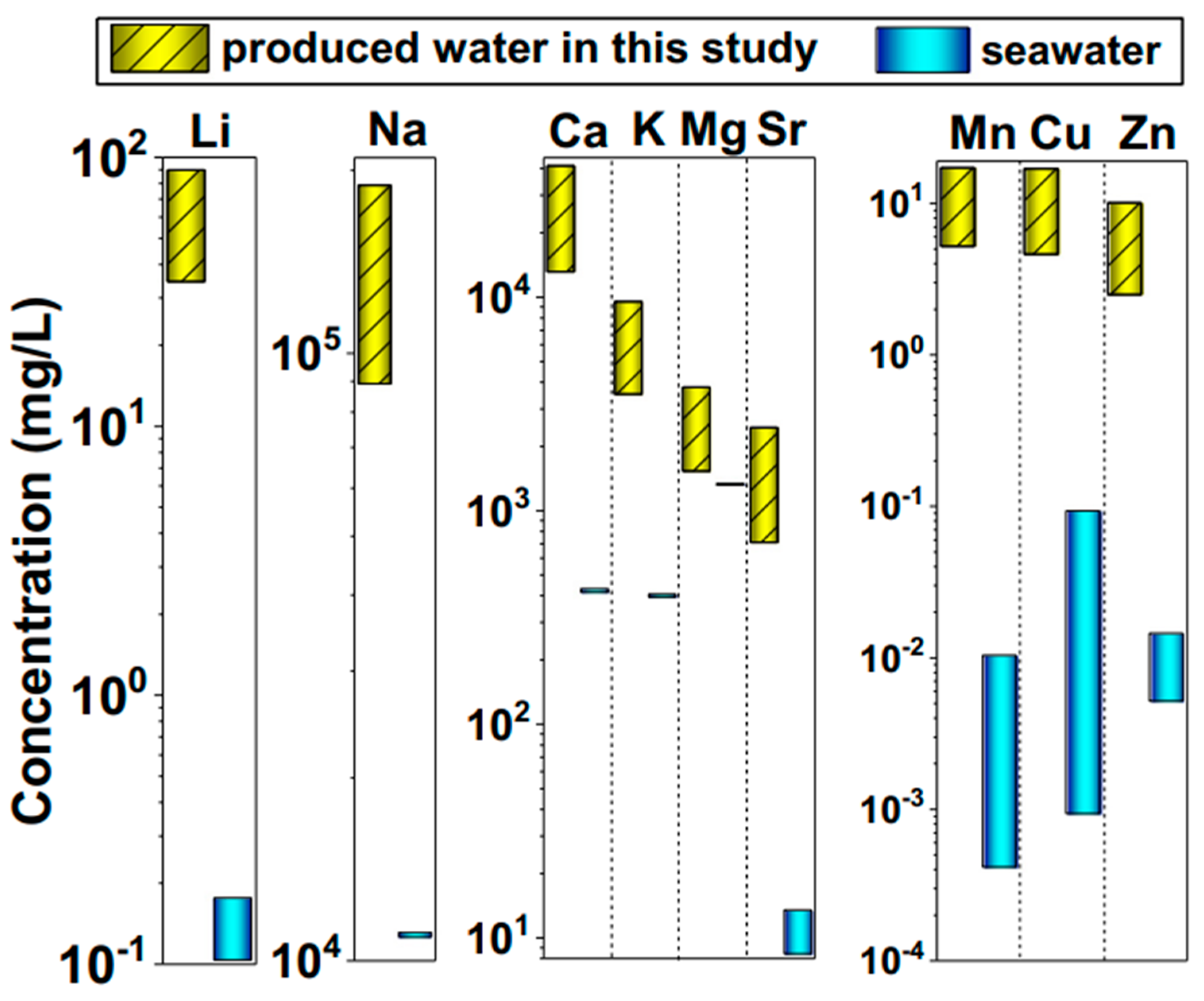
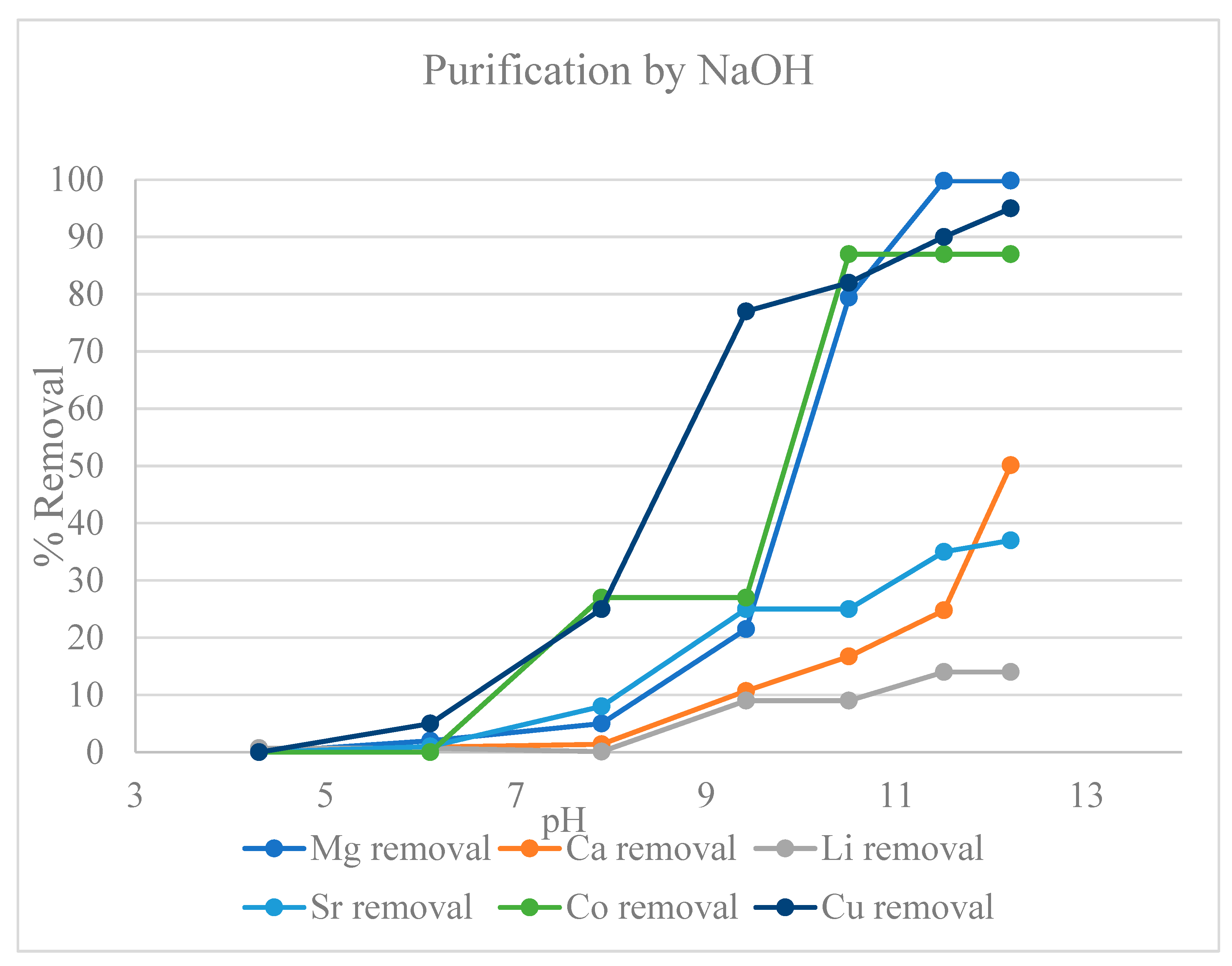

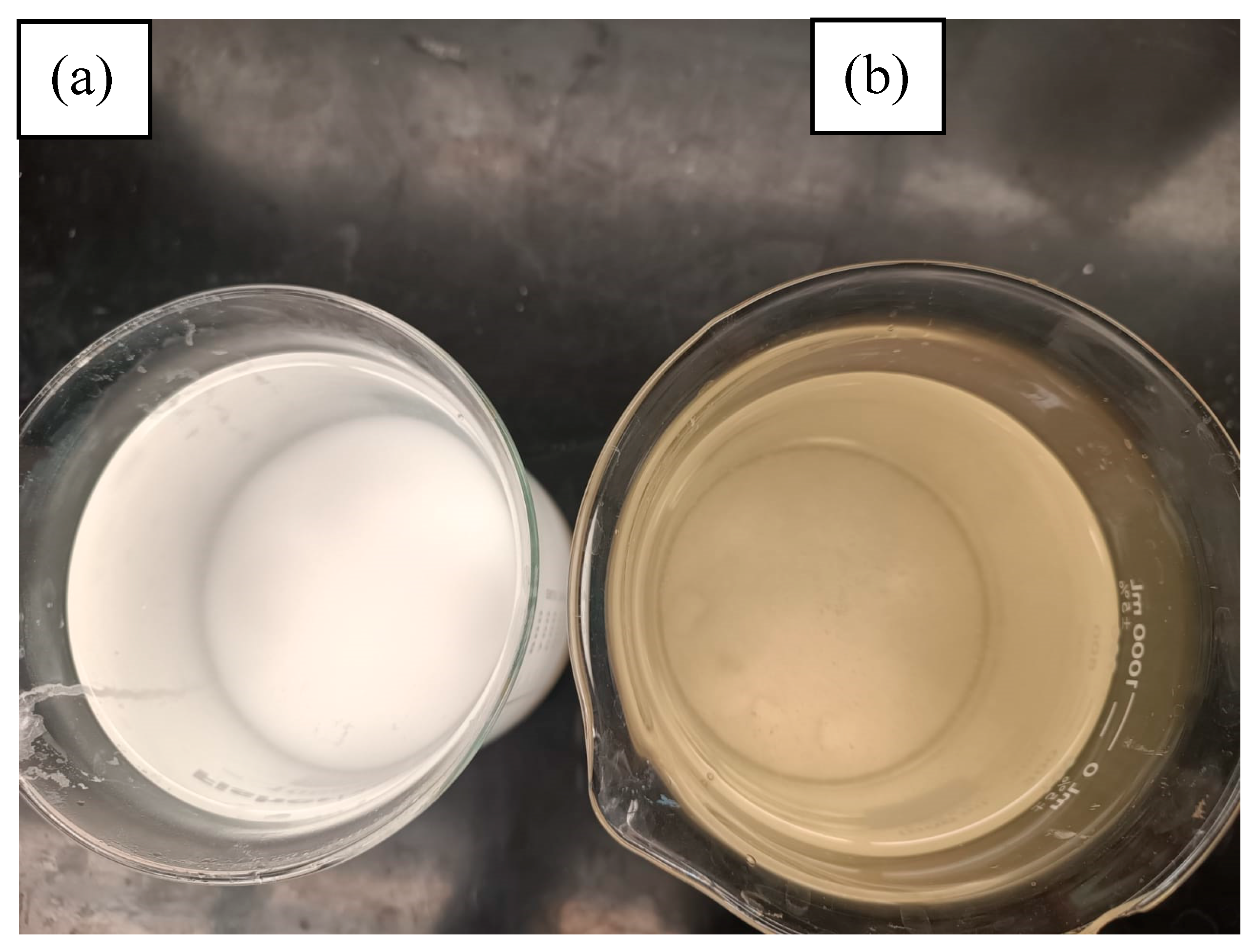
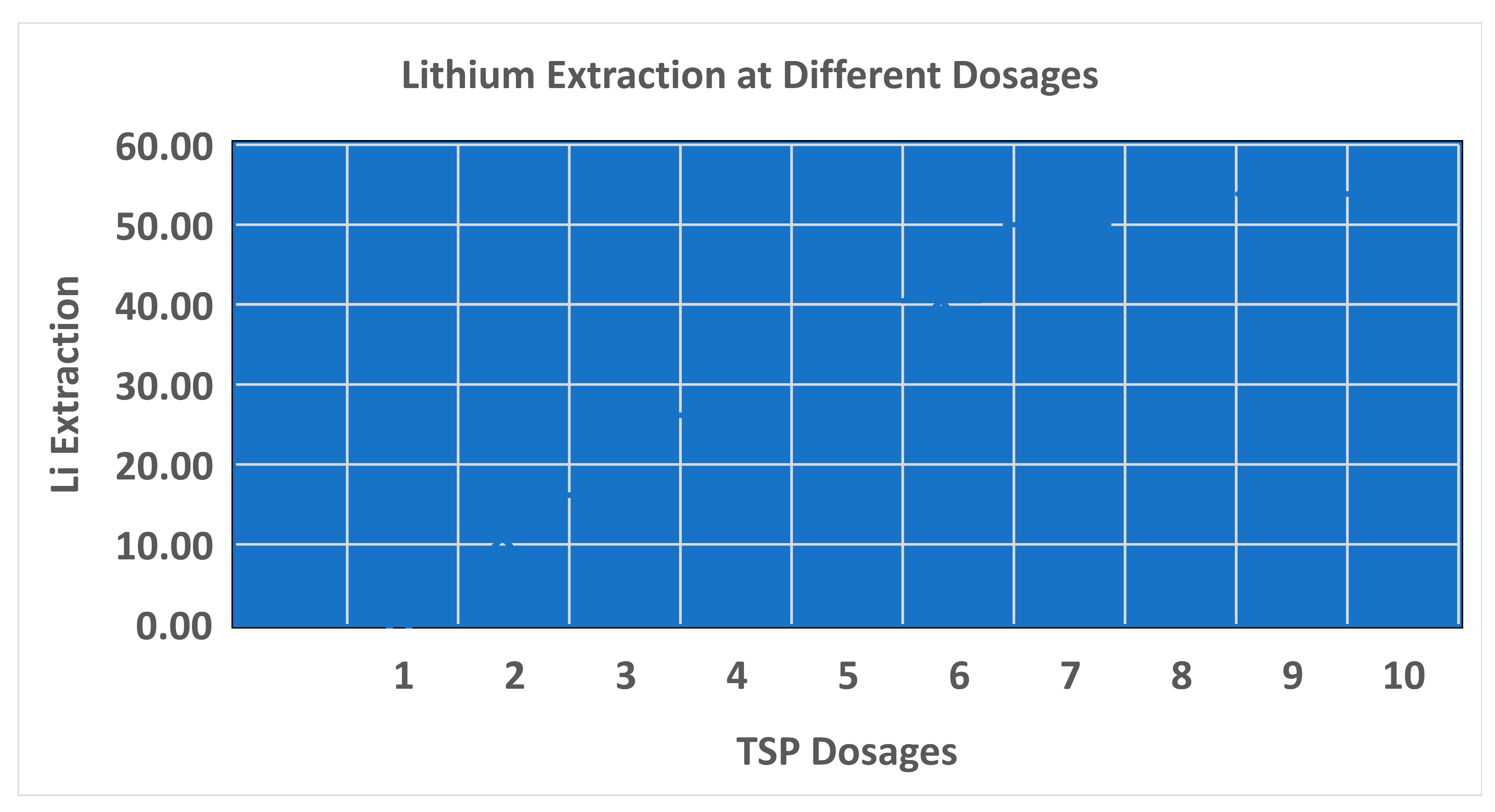
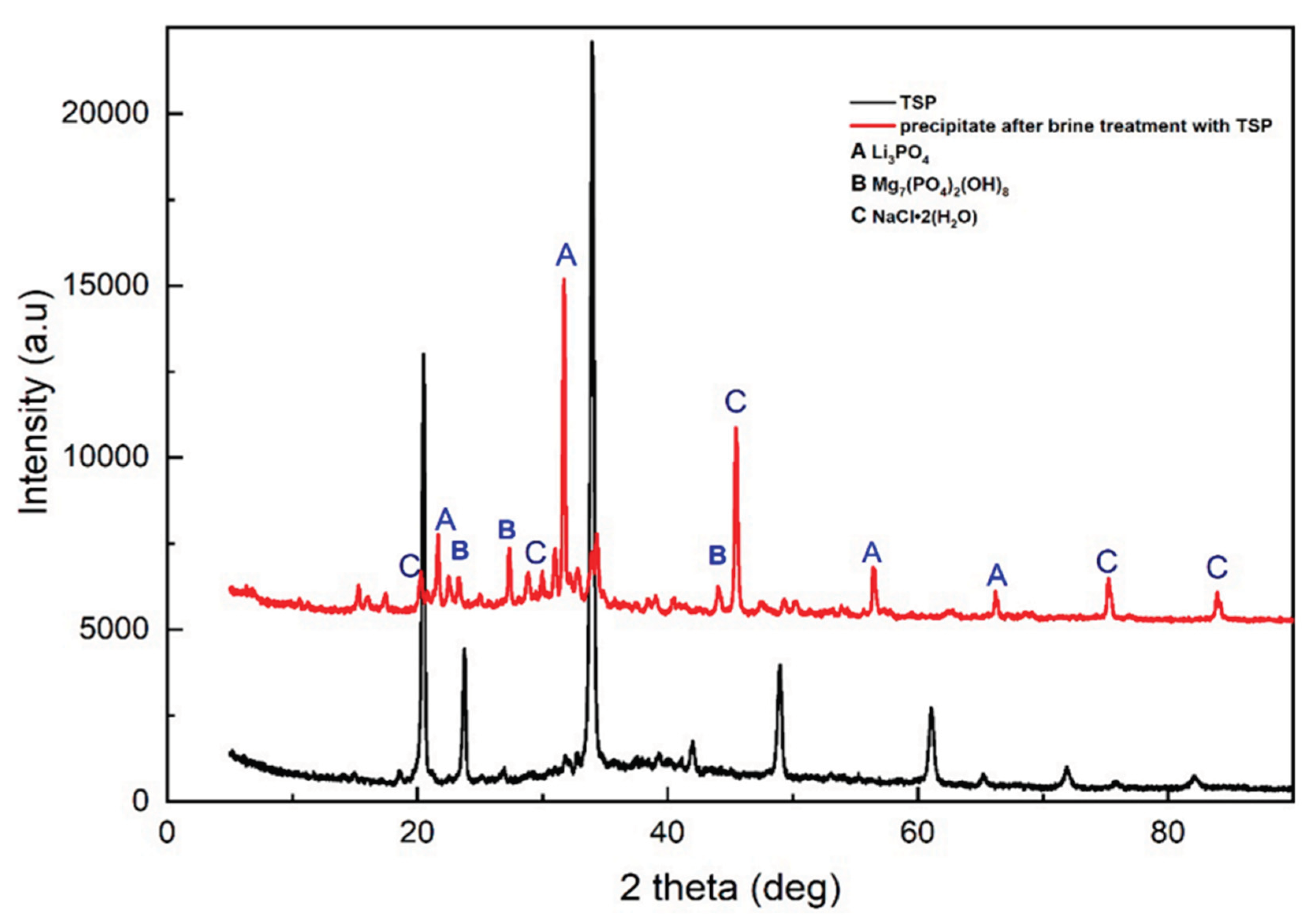
| Results | |||
|---|---|---|---|
| Parameters | Units | PW1 | PW2 |
| pH | - | 4.5 | 5.2 |
| Conductivity | mS/cm | 98 | 135 |
| Alkalinity | (mg/L as CaCO3) | 140 | 120 |
| Chemical Oxygen Demand (COD) | mg/L | 380 | 120 |
| Suspended Solids (TSS) | mg/L | 220 | 180 |
| Total Organic Carbon (TOC) | mg/L | 11 | 4 |
| Color | - | Clear yellow | Clear yellow |
| Odor | - | significant | Not significant |
| Chloride | mg/L | 76,300 | 39,561 |
| Sulfate | mg/L | 2.5 | 0.3 |
| Lithium (Li) | mg/L | 53.5 | 22 |
| Calcium (Ca) | mg/L | 11,580 | 3221 |
| Magnesium (Mg) | mg/L | 1070 | 305 |
| Sodium (Na) | mg/L | 43,250 | 11,750 |
| Iron( Fe) | mg/L | 1.1 | 0 |
| Strontium (Sr) | mg/L | 1317 | 249 |
| Manganese (Mn) | mg/L | 0.8 | 0 |
| Aluminium (Al) | mg/L | 0.23 | 0 |
| pH | Temperature °C | Li (mg/l) | Mg (mg/l) | Ca (mg/l) | |
|---|---|---|---|---|---|
| Actual sample | 4.5 | 23 | 53.6 | 1070 | 11580 |
| Purification process (NaOH addition) | 11.5 | 23 | 52.1 | 1.2 | 6240 |
| DSP (2g) | 45 | 0 | - | ||
| STP (2g) | 10.45 | 50 | 41.2 | 0 | - |
| TSP (2g) | 39.2 | 0 | - | ||
| Selected reagent (TSP) (TSP=5, 7, 10, 15 g) dosage |
11 | 50 | (37.5-39) | 0 | - |
| TSP (10g) | 10.5 | (50,60,80) | (40.5-42.7) | 0 | - |
| Removal% | 25% | - |
Disclaimer/Publisher’s Note: The statements, opinions and data contained in all publications are solely those of the individual author(s) and contributor(s) and not of MDPI and/or the editor(s). MDPI and/or the editor(s) disclaim responsibility for any injury to people or property resulting from any ideas, methods, instructions or products referred to in the content. |
© 2024 by the authors. Licensee MDPI, Basel, Switzerland. This article is an open access article distributed under the terms and conditions of the Creative Commons Attribution (CC BY) license (http://creativecommons.org/licenses/by/4.0/).




